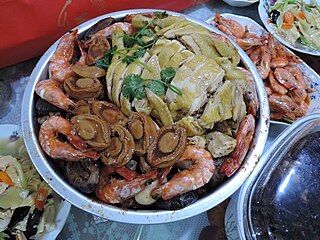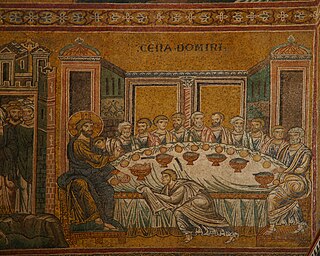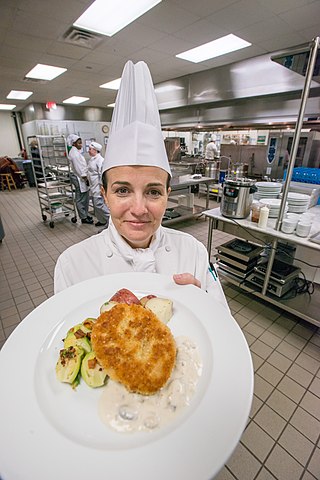
A restaurant is a business that prepares and serves food and drinks to customers. Meals are generally served and eaten on the premises, but many restaurants also offer take-out and food delivery services. Restaurants vary greatly in appearance and offerings, including a wide variety of cuisines and service models ranging from inexpensive fast-food restaurants and cafeterias to mid-priced family restaurants, to high-priced luxury establishments.

A festival is an event celebrated by a community and centering on some characteristic aspect or aspects of that community and its religion or cultures. It is often marked as a local or national holiday, mela, or eid. A festival constitutes typical cases of glocalization, as well as the high culture-low culture interrelationship. Next to religion and folklore, a significant origin is agricultural. Food is such a vital resource that many festivals are associated with harvest time. Religious commemoration and thanksgiving for good harvests are blended in events that take place in autumn, such as Halloween in the northern hemisphere and Easter in the southern.
Dinner usually refers to what is in many Western cultures the biggest and most formal meal of the day. Historically, the largest meal used to be eaten around midday, and called dinner. Especially among the elite, it gradually migrated to later in the day over the 16th to 19th centuries. The word has different meanings depending on culture, and may mean a meal of any size eaten at any time of day. In particular, it is still sometimes used for a meal at noon or in the early afternoon on special occasions, such as a Christmas dinner. In hot climates, the main meal is more likely to be eaten in the evening, after the temperature has fallen.
The following outline is provided as an overview of and topical guide to meals:

Poon choi or puhn choi, pén cài in pinyin, is a traditional Cantonese festival meal composed of many layers of different ingredients. It is served in large wooden, porcelain or metal basins called poon, due to the communal style of consumption. The Chinese name, transliterated as Poon choi, has been variously translated as "big bowl feast", "basin cuisine" or "Chinese casserole".

A banquet is a formal large meal where a number of people consume food together. Banquets are traditionally held to enhance the prestige of a host, or reinforce social bonds among joint contributors. Modern examples of these purposes include a charitable gathering, a ceremony, or a celebration. They often involve speeches in honor of the topic or guest of honour.

Culinary arts are the cuisine arts of food preparation, cooking, and presentation of food, usually in the form of meals. People working in this field – especially in establishments such as restaurants – are commonly called chefs or cooks, although, at its most general, the terms culinary artist and culinarian are also used. Table manners are sometimes referred to as a culinary art.

Table manners are the rules of etiquette used while eating, which may also include the use of utensils. Different cultures observe different rules for table manners. Each family or group sets its own standards for how strictly these rules are to be followed.

Some Christian denominations place the origin of the Eucharist in the Last Supper of Jesus with his disciples, at which he is believed to have taken bread and given it to his disciples, telling them to eat of it, because it was his body, and to have taken a cup and given it to his disciples, telling them to drink of it because it was the cup of the covenant in his blood.

The sociology of food is the study of food as it relates to the history, progression, and future development of society, encompassing its production, preparation, consumption, and distribution, its medical, ritual, spiritual, ethical and cultural applications, and related environmental and labor issues.

Diet in Hinduism signifies the diverse traditions found across the Indian subcontinent. Hindu scriptures promote a vegetarian dietary ideal based on the concept of ahimsa—non-violence and compassion towards all beings. According to a Pew Research Center survey, 44% of Hindus say they are vegetarian.

Food presentation is the art of modifying, processing, arranging, or decorating food to enhance its aesthetic appeal.

Customs and etiquette in Chinese dining are the traditional behaviors observed while eating in Greater China. Traditional Han customs have spread throughout East Asia to varying degrees, with some regions sharing a few aspects of formal dining, which has ranged from guest seating to paying the bill.

Purity and Danger: An Analysis of Concepts of Pollution and Taboo is a 1966 book by the anthropologist and cultural theorist Mary Douglas. It is her best known work. In 1991 the Times Literary Supplement listed it as one of the hundred most influential non-fiction books published since 1945.
Meal preparation, sometimes called meal prep, is the process of planning and preparing meals.

Kamayan is a Filipino cultural term for the various occasions or contexts in which pagkakamay is practiced, including as part of communal feasting. Such feasts traditionally served the food on large leaves such as banana or breadfruit spread on a table, with the diners eating from their own plates. The practice is also known as kinamot or kinamut in Visayan languages.

A meal is an eating occasion that takes place at a certain time and includes consumption of food. The names used for specific meals in English vary, depending on the speaker's culture, the time of day, or the size of the meal.

Rat meat is the meat of various species of rat: medium-sized, long-tailed rodents. It is a food that, while taboo in some cultures, is a dietary staple in others. Taboos include fears of disease or religious prohibition, but in many places, the high number of rats has led to their incorporation into the local diets.

Japanese dining etiquette is a set of traditional perceptions governing specific expectations which outlines general standards of how one should behave and respond in various dining situations.

When have we eaten from the same dish? is a Spanish idiom about someone who has "taken too many liberties" and caused irritation or offense. It is usually made as hierarchical social commentary about poor manners or incivility, said to someone perceived to be acting above their social standing, position, class or rank. It is also used as a statement, When we have eaten from the same dish.


















